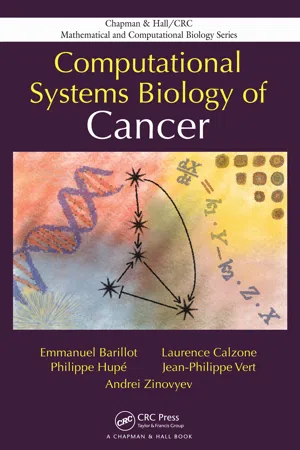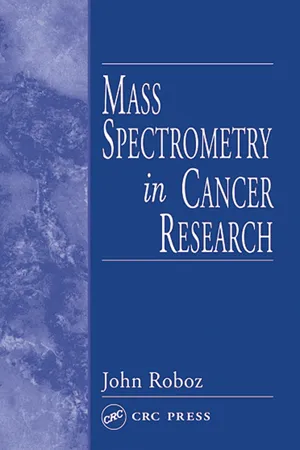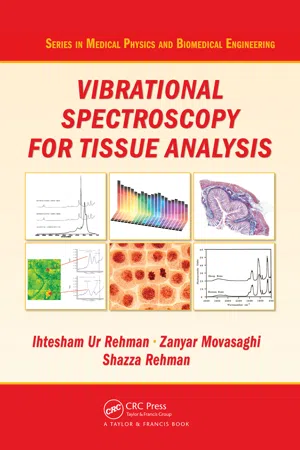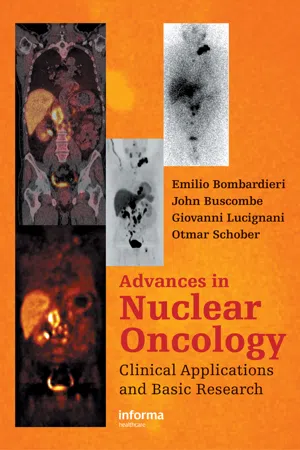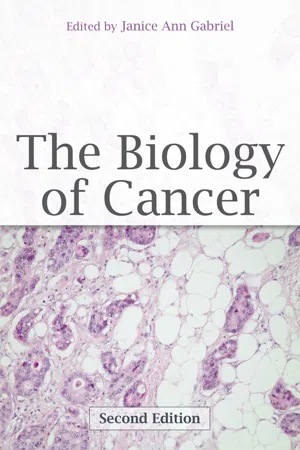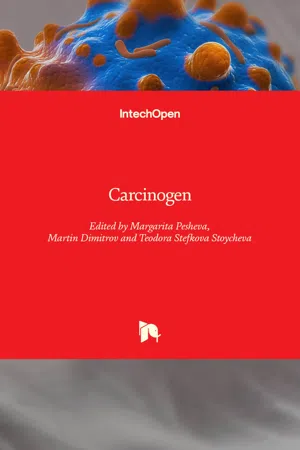Biological Sciences
Cancer Cells
Cancer cells are abnormal cells that divide uncontrollably and can invade other tissues. They differ from normal cells in their ability to ignore signals that regulate cell growth and death. These cells can form tumors and spread to other parts of the body, leading to the development of cancer.
Written by Perlego with AI-assistance
Related key terms
1 of 5
10 Key excerpts on "Cancer Cells"
- eBook - PDF
- Caterina A. M. La Porta, Stefano Zapperi(Authors)
- 2017(Publication Date)
- Cambridge University Press(Publisher)
2 The Biology of Cancer Cancer results from abnormal cellular growth. It is considered to be benign when localised in situ while it is defined to be malign and metastatic when it is invasive and spreads inside the body through blood or lymphatic vessels. Cancer progres- sion can be interpreted as an evolutionary process, as we discuss in Section 2.1. In spite of the increasing knowledge gained on the molecular mechanisms involved in the deregulation of Cancer Cells, such as the identification of many oncogenes and oncosuppressors (discussed in Section 2.2), many open questions still exist about the origin of Cancer Cells. In Section 2.3, we introduce a key oncosuppressor gene which is of fundamental importance for cancer development: P53, also known as the “guardian of the genome.” While important oncogenes and oncosuppressors clearly exist, cancer involves a multitude of different genes requiring an integrative data-based approach (Section 2.4). Another important issue that is still under investigation is the presence of a sub- population of more aggressive Cancer Cells, usually described as cancer stem cells (Section 2.5) (CSCs). The molecular aspects related to the capability of Cancer Cells to receive nutrients from the environment through existing vessels, and the ability of the same Cancer Cells to induce vessel formation (angiogenesis), are two critical aspects of the biology of cancer that we illustrate in Section 2.6. Further- more, in Section 2.7, we illustrate the spread of Cancer Cells inside the body in the metastatic process. All together these aspects will be discussed here, combining biological and physical viewpoints. In this perspective, the cancer ecosystem is the combination of physical forces and biochemical ingredients. Finally, the new diag- nostic tools for the identification of a cancer cell are also discussed and critically reviewed (Section 2.8). - eBook - ePub
Biomaterials for Cancer Therapeutics
Diagnosis, Prevention and Therapy
- Kinam Park(Author)
- 2013(Publication Date)
- Woodhead Publishing(Publisher)
2Cancer cell biology
R. Mrsny, University of Bath, UKAbstract:
Cancer remains the most challenging of diseases to treat for a variety of reasons. While Cancer Cells are derived from normal cells of the body, and thus would not normally be considered dangerous, their unregulated growth and dissemination to multiple vital organs provide these cells with the ability to induce significant morbidity and ultimately mortality. Challenges to successfully treat Cancer Cells include the fact that they utilize endogenous mechanisms of cell growth and division, and that they are genetically unique to each patient and to each form of cancer. In order to identify successful pharmacotherapies to selectively target and treat Cancer Cells, an improved understanding of cellular processes involving oncogenesis as well as cancer cell growth and metastasis must be obtained.Key words cancer cell biology genetic drivers of cancer environmental factors affecting cancer2.1 Introduction
Cancer is a poorly defined term used to describe a hugely diverse set of cellular modifications that result in uncontrolled cell growth and their aberrant distribution in the body. Traditionally, strategies to treat a particular type of cancer have been based upon the tissue and cell type of its origin. With the advent of personalized medicine and an improved ability to examine genetic and biological changes that occur when cells become cancerous, it has become clear that no two cancers are identical and that these traditional groupings and the associated approved therapies may not necessarily lead to an effective outcome. While many valid generalizations are made every day by oncologists when dealing with patients with a particular type of cancer, effective cancer treatments for many patients are still not available. The goal of this chapter is to highlight the disparate nature of cells that are commonly termed cancerous and to examine some cellular processes that may more accurately define these cells. It is hoped that with a sufficient appreciation of cell biology events that affect and control Cancer Cells, cancer will one day be treated as a chronic or transient condition rather than a death sentence. Each section of this chapter highlights cancer cell biology aspects that can affect the potential for such treatments. - eBook - PDF
- Emmanuel Barillot, Laurence Calzone, Philippe Hupe, Jean-Philippe Vert, Andrei Zinovyev(Authors)
- 2012(Publication Date)
- CRC Press(Publisher)
Chapter 2 Basic principles of the molecular biology of cancer The human body consists of billions of different cells and thousands of cell types organised in many tissues. These cells complete their specific func-tion according to a program using an information flow proposed by Crick (1970) in the central dogma of molecular biology (see Appendices ). Can-cer cells arise from these normal cells. Cancers are classified into four large groups according to the normal cell from which they originate. The majority of cancers (80%) arise from ephitelial normal cells and forms the first group called carcinomas * ( e.g. breast, ovary, cervix, prostate, lung, pancreas, colon, etc. ). All the other cancers arise from nonepithelial normal cells. The second group contains sarcomas * which derive from connective or supportive tissue ( e.g. bone, cartilage, fat, muscle, blood vessels) and soft tissues. The third group arises from hematopoetic tissues ( i.e. blood-forming cells) and includes lymphomas * and leukaemias * . The last group consists of tumours arising from the central and peripheral nervous system and includes glioblastomas * , neuroblastomas * , schwannomas * and medulloblastomas * . All cancers form solid tumours except in the case of leukaemias which generate circulat-ing tumoral cells in the blood. Cancer is a heterogeneous disease in terms of morphological, clinical and molecular characteristics (see Section 1.4 ). Despite this heterogeneity, cancers share many characteristics. They are described throughout this chapter which presents the series of events that transform a normal cell into a cancer cell during tumour progression * . The molecular alterations which affect gene regulation and signal transduc-tion mechanisms are detailed. The traits common in all cancers referred to as hallmarks , are enumerated in turn with a particular focus on chromosome aberrations. - eBook - PDF
- John Roboz(Author)
- 2002(Publication Date)
- CRC Press(Publisher)
81 Relevant Concepts of Cancer Medicine and Biology 3.1 CLASSIFICATION AND EPIDEMIOLOGY The words tumor (Latin, tumere = to swell) and neoplasm (neo = new, plasma = formation) are used synonymously to describe abnormal tissues characterized by unregulated cellular growth to form a mass without a defined structure. The pathologic process that results in the formation and growth of neoplasms is called neoplasia. Cancer (Latin, for crab) is a general term used to describe any of various types of malignant neoplasms causing over 200 diseases of multicellular organisms. Cancers share several characteristics, including that they originate from mutant, genetically dys- functional cells; they escape normal growth controls; and they invade and colonize normal tissues. On its way to becoming a full-fledged malignant tumor, a nascent neoplastic clone must prevail through a remarkable series of events and must undertake a number of exceptional maneuvers. These include bypassing programmed cell death, circumventing growth restraining signals, growing without growth factors from other cells, evading immunological surveillance, appropriating a vascular supply, burrowing into surrounding tissues, traversing blood or lymph vessels to travel to distant sites, recognizing an appropriate environment for crossing out of the vessels, and finally establishing secondary tumors. Only about 0.1% of the breakaway cells survive after entering the circulation, and most of those are captured in the first capillary bed encountered. In the specific case of cells in the lymph system, those cells arrested in the subcapsular sinuses of the lymph nodes may begin to grow. Other lymph borne-malignant cells may enter the blood vascular system via the lymphatic interconnections in the venous system. 3.1.1 S OLID T UMORS All solid neoplasms have a parenchyma that comprises the neoplastic proliferating cells and a stroma that consists of the supporting connective tissue and blood supply required for growth. - eBook - PDF
- Ihtesham ur Rehman, Zanyar Movasaghi, Shazza Rehman(Authors)
- 2012(Publication Date)
- CRC Press(Publisher)
33 3 The Biology of Cancer To understand chemical structural properties of cancer and associated changes with the progression of disease, it is important to understand the biology and chemistry of cancer. The term neoplasia , which literally means new growth , is used clinically to describe pathologic tissue masses, which grow independent of and faster than normal tissues. Most of the body cells repair and reproduce themselves similarly in spite of their dif-ferent functioning and appearance. As long as this process takes place in an orderly manner, everything is under control. However, when it gets out of control, a lump, called a tumour , develops. A neoplasm (tumour) may be classified as in situ, benign, or malignant, based on its potential to harm the host body. Malignant tumours are also called cancers [1,2,3]. Benign tumours are not considered cancer. They do not threaten life because they do not spread to other organs, and once they are removed, they rarely reappear. In situ tumours look like cancer in their morphology. In gen-eral, they develop in epithelium. These small tumours remain in the epi-thelial layer. A malignant tumour consists of Cancer Cells that sometimes spread away from the original (primary) cancer to other organs through the lymphatic system and bloodstream causing damage to organs and tis-sues near the tumour. When they get to another part of the body, they may divide forming a new tumour called a secondary or a metastasis tumour [4]. A biopsy is used by doctors to decide whether a tumour is benign or can-cerous in which a small sample of cells is examined under a microscope. Uncontrolled growth is the core property of cancers, which were known to the early Egyptians [3,5]. Hippocrates reportedly distinguished benign from malignant tissues [6]. - eBook - PDF
Advances in Nuclear Oncology
Diagnosis and Therapy
- Emilio Bombardieri, John Buscombe, Giovanni Lucignani, Otmar Schober, Emilio Bombardieri, John Buscombe, Giovanni Lucignani, Otmar Schober(Authors)
- 2007(Publication Date)
- CRC Press(Publisher)
1 What is cancer? Uwe Haberkorn At first sight cancer is a disease induced by the failure of control mechanisms. The cancer cell does not respond to control signals because of damage to its DNA, the presence of oncogene products, or because the homeostatic control mechanisms themselves are disturbed. Biologically this corresponds to uncontrolled proliferation occurring at the wrong place and time driven by oncogenic signals, impaired differentiation, and invasion of other tissues lead-ing to metastases. In a recent review, Hanahan and Weinberg mentioned six essential alterations in cell physiology which are seen as the hallmarks of cancer: self-sufficiency in growth signals, insensitivity to growth-inhibitory signals, evasion of programmed cell death (apoptosis), limitless replicative potential, sustained angiogenesis, and tissue invasion and metastasis. These alterations are interpreted as results of genetic changes in the cancer cell. However, mutations in the tumor genome may not be the only cause. 1 Genetic and epigenetic background Cancer has been viewed as a multistep process of genetic alterations that result in the transformation of benign cells into malignant ones. These genetic abnormalities include mutations in tumor-suppressor genes and oncogenes, and chromosomal abnormalities such as chromosomal gain, loss, and/or rearrangement (Table 1.1). 1,2 Such events are thought to be followed by a clonal selection of variant cells that show increasingly aggressive behavior. 3 Although it is still commonly thought that aneuploidy occurs as a late-stage effect rather than as a cause of cancer development, this might not always be true, as carcinogens such as asbestos and arsenic initially do not cause gene mutations, but rather lead to aneuploid lesions. Further-more, normal cells exposed to chemical carcinogens can become aneuploid long before they show signs of being cancerous. - eBook - PDF
- Kathleen A. Ireland(Author)
- 2018(Publication Date)
- Wiley(Publisher)
Only a scant few mistakes creep through. Despite the fact that a few of these cells become cancerous, due to our incredibly adept immune surveillance system, barely one-third of us will develop cancer in our lifetimes. Cancer is not a single disease. Actually, more than 100 specific diseases are lumped together under the term cancer. Each form of cancer requires a specific form of treatment. As we learn more about various cancers, we are continually refining treatment regimens, to the point where each individual’s treatment regimen is truly a “per- sonal” plan designed to fight a personal cancer. Medicine has moved beyond the three pillars of previous cancer therapy—surgery, che- motherapy, and radiation—to embrace such techniques as immuno- therapy, anti-hormone therapy, and genetic and molecular therapy, in an effort to fight cancerous cells more precisely. The more we learn about the genetic component of cancer, the closer we come to being able to treat cancers before they occur by replacing defective genes. Cancer Cells Have Certain Characteristics Cancer describes a series of diseases that all have common charac- teristics. The most striking of these is that Cancer Cells lose control over their own growth. Unlike normal cells, Cancer Cells either disre- gard or don’t receive the chemical signals that tell them it is time to stop dividing and die. They break away from nearby cells and begin a cycle of uncontrolled, often rapid division and replication. In general terms, cancer can be defined as uncontrolled cell replication that occurs because of a breakdown in the normal mechanisms of cell regulation. Along with this lack of growth control, all cancers have other common characteristics: • Cancer Cells lack differentiation. A cancer cell is not differenti- ated, meaning that it has no specified function and therefore can make no contribution to the overall functioning of a particular body part. - eBook - PDF
- Janice Gabriel(Author)
- 2006(Publication Date)
- Wiley(Publisher)
It is this group of cells that accounts for about 70% of cancers (Venitt, 1978; Corner, 2001). However, any cell has the potential to undergo malignant changes and lead to the development of a carcinoma. The ‘tumour’ cells are not only confined to localized ‘overgrowth’ and infiltration of surrounding tissue, but can also spread to other parts of the body via 4 The biology of cancer the lymphatic system and bloodstream, creating secondary deposits known as ‘metastases’ (Walter, 1977; BMA, 1997). The ‘normal’ cell control mechanisms become disrupted or indeed fail (Corner, 2001). Surgical removal of the original tumour is not always a successful treat- ment in malignant disease, as a result of microscopic spread. Malignant tumours are often irregular in shape with ill-defined margins (Walter, 1977; Wolfe, 1986). Microscopic spread results in the tissue surround- ing the visible tumour appearing unaffected by disease. However, microscopic examination of the surgical resection margins can reveal the presence of malignant cells. If left untreated, these cells will result in localized recurrence of the cancer and eventual spread. The spread of the malignant cells extends outward from the original tumour and has been described as resembling the appearance of a crab. Historically this has been traced back to the origins of the term ‘cancer’, which was derived from the Latin word for ‘crab’ (Walter, 1977). Generally, the earlier that a cancer is detected, the less likely it is to metastasize, and so the more favourable the prognosis for the individual. Metastatic spread All cells replicate themselves. This is usually about 50–60 times before the cell eventually dies (LeMarbre and Greonwald, 2000; Corner, 2001). However, as malignant cells replicate they grow in an irregular pattern, infiltrating surrounding tissue. This can result in infiltration of the lymphatics and/or blood vessels. - eBook - PDF
- Janice Ann Gabriel(Author)
- 2007(Publication Date)
- Wiley(Publisher)
Extracellular matrix proteins have to be degraded by enzymes released from the tumour or the surrounding cells (Chambers and Matrisian, 1997). The multistage theory of cancer has become further complicated with the recent discovery of cancer stem cells (Reya et al., 2001). Normal stem cells repair and renew our tissues, but recent research has focused on the idea that these have a kind of ‘evil twin’, a cancer stem cell (Abbott, 2006). These would make up just a tiny subset of the cells in a cancer, but are proposed to be able to proliferate and self-renew extensively, thus sustaining tumour growth. These cells were first isolated in leukaemias (Bonnet and Dick, 1997), but have now also been found in some solid tumours, including brain (Clarke, 2004) and prostate (Collins et al., 2005) cancers. This has very important implications for treatment as, rather as a weed can grow back from its roots, it is very conceivable that only the eradication of these cells can lead to an effective cancer cure. Cancer stem cells might arise from the mutational transformation of normal stem cells, while in other cases mutations might cause non-stem cells cells to acquire stem cell properties (Pardal, Clarke and Morrison, 2003). Cancer genes can be divided into three main groups, according to whether they activate cellular proliferation (oncogenes), inhibit proliferation (tumour suppressors) or participate in DNA repair (Strachan and Read, 1999). ONCOGENES Oncogenes were the first cancer-causing genes to be identified; they activate cellular proliferation, leading to unregulated cell growth and differentiation (Ponder, 2001). Most oncogenes are derived from a non-mutant version of the gene known as a ‘proto-oncogene’, which is usually involved in normal cellular growth. When a mutation occurs in a proto-oncogene, it can become transformed to form an onco-gene (Varmus, 1985). - eBook - PDF
- Margarita Pesheva, Martin Dimitrov, Teodora Stefkova Stoycheva, Margarita Pesheva, Martin Dimitrov, Teodora Stefkova Stoycheva(Authors)
- 2012(Publication Date)
- IntechOpen(Publisher)
Section 1 Model of Carcinogenesis 1 The New Model of Carcinogenesis: The Cancer Stem Cell Hypothesis Brenda Loaiza, Emilio Rojas and Mahara Valverde Universidad Nacional Autónoma de México, Instituto de Investigaciones Biomédicas México 1. Introduction Cancer has long been seen as a disease that arises from mutations and epigenetic alterations that impair the capacity of any cell within the organism to deregulation its proliferation, avoid apoptosis and metastasis, giving rise to malignant transformation. Progressively, these early Cancer Cells lead to different generations of daughter cells that accumulate additional mutations, acting in concert to drive the full neoplastic phenotype. Adult stem cells are found in numerous tissues of the body and play an important role in tissue development, replacement and repair. In addition, these cells show long-term replicative potential, together with the capacities of self-renewal and multi-lineage differentiation. These stem cell properties are tightly regulated in normal development, therefore their alteration may be a critical issue for tumorigenesis. The Cancer Stem Cell (CSC) theory arises from the poor probability of short-lived differentiated progenitors or terminally differentiated cells to accumulate mutations that become cancer. On the other side, the normal tissue stem cells or early progenitors that already possess the most important characteristics of cancer are an easy target for the accumulation of genetic aberrations which lead to cancer formation. The new defining model for carcinogenesis, the cancer stem cell theory was put forward since 1997, when John Dick and coworkers started a series of pioneering investigations to understand whether the functional hierarchy observed in normal hematopoiesis was conserved in blood tumors (Bonnet & Dick, 1997). According to this model cancer is a stem cell disease that places malignant stem cells at the centre of its tumorigenic activity.
Index pages curate the most relevant extracts from our library of academic textbooks. They’ve been created using an in-house natural language model (NLM), each adding context and meaning to key research topics.


